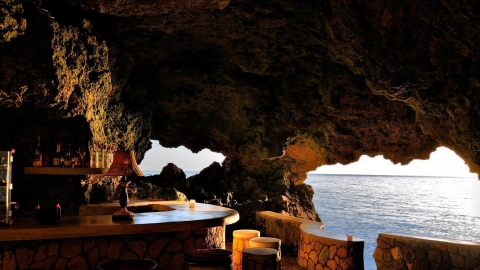The bow tie was tied. The trombone was raised. At the corner of Dauphine and Toulouse, USA, two policemen on motorcycles stopped to make way for something more sacred than music.
From afar, the first notes of “Just a Closer Walk with Thee” rang out from a trumpet, then saxophones and sousaphones joined in, leading the band through the streets of New Orleans. Behind them, the crowd followed, the farewell music gradually changing from sorrow to joy, like the human journey from separation to rebirth.
Funeral Second Line is a unique cultural practice in New Orleans. Drawing from West African and Caribbean beliefs, it transforms grief into celebration, where music helps the living honor the lives of those who have passed away. Here, a trombone can stop traffic and a sousaphone can bring thousands of people into the streets.

The Kinfolk Brass Band marches near Jackson Square in New Orleans. Photo: Will Lanzoni/CNN
At the center of each parade is the brass band, musicians in white shirts and pressed black pants who carry a responsibility greater than their instruments: the spirit of the community. In New Orleans, farewells are sent off with brass bands, and it is the sound of brass bands that turns departures into celebrations of life.
Fingerprints of sound and rhythm

Artist Roger Lewis at City Park in New Orleans. Photo: Will Lanzoni/CNN
“If you grow up here, the African drums, the dances – it's all in our DNA,” says Roger Lewis, 83, smiling.
As a founding member of the legendary Dirty Dozen Brass Band, Lewis has taken New Orleans music around the world, alongside legends like Dizzy Gillespie and Elvis Costello. The group won a Grammy in 2023, appeared in numerous films, and their song “Feet Can't Fail Me Now” has become a symbol of the city.
After every tour, Lewis still returns to the Bywater neighborhood, playing trumpet in a small studio for a nonprofit that accepts only quiet donations. In New Orleans, music doesn’t need a big stage; the entire city is a live music scene, where the heart beats instead of the lights.
When music rises from the heart of the street
Jazz legend Ellis Marsalis once said, “In New Orleans, culture doesn’t fall from the sky, it rises from the streets.” And indeed, the streets are the real stage, where music resonates from the heart.
From the late 19th century, when soldiers brought military instruments into civilian life, brass band music was born with wildness, freedom and full of identity. In the 1970s and 1980s, when funk and rock rose, New Orleans music also changed, became more vibrant, but still kept the old soul.

The Eureka Brass Band performs during the Jazz Sunday Parade in the French Quarter, 1960. Photo: Archive Photos/Getty Images.
Roger Lewis proudly said: “We still play the same old songs, but stronger and more lively. I often joke: bring sneakers, because you can lose 40 pounds if you join us for the whole show.” In New Orleans, music is not just to listen to, but to live, to dance, to feel the breath of the community. From small street corners to fiery music nights, every note of the horn carries the soul of the city - a sound that cannot be found anywhere else.
Sounds of Homeland
In the early 1980s, three young men, Kermit Ruffins, Keith Frazier, and Phillip “Tuba Phil” Frazier, formed the Rebirth Brass Band as high school students in the Treme neighborhood. Too young to get into bars, they took their music to the streets and “reborn” the brass band spirit by blending jazz, funk, and hip-hop.

The Shotgun Jazz Band performs at The Spotted Cat in New Orleans. Photo: Will Lanzoni/CNN

The Spotted Cat in New Orleans. Photo: Will Lanzoni/CNN
Rebirth quickly became a new symbol of the city, winning a Grammy, releasing 17 albums, and maintaining a tradition of performing every Tuesday night. “With these instruments, you can create anything,” Keith Frazier says. In New Orleans, music is reborn with each generation, each drum beat, each horn. Each neighborhood has its own flavor: Uptown is vibrant, Tremé is traditional, and New Orleans East is hip-hop. Every street has a melody, every neighborhood a note in the city’s endless symphony.
New breath among old melodies

Christie Jourdain of The Original Pinettes in New Orleans. Photo: Will Lanzoni/CNN.
Brass bands have long been a male-dominated scene. But in New Orleans, that is changing dramatically and gently, as women are rewriting the musical narrative. Christie Jourdain, leader of The Original Pinettes, the city’s first all-female brass band, recalls: “Back then, people said female bands were just ‘for fun.’ But when the horns sounded, the whole place exploded, and from that moment on, all the doors opened.”
The Original Pinettes won the Red Bull Street Kings competition in 2013 with such a resounding victory that the sponsors changed the name to Red Bull Street Queens. They now perform at major music festivals like Jazz Fest and the French Quarter Festival.

The Original Pinettes Brass Band in 2023. Photo: Erika Goldring/Getty Images
From their legacy, a new generation continues. Maude Caillat - leader of Bra's Band Brass Band, an all-female band founded in 2021 shared: "Women are still rare in this industry. Not only because we have to carry tubas that weigh tens of kilograms, but also because we have many other roles: mothers, wives." Female artists now often perform at events for women or community fundraisers. Even though they have to do other jobs to make a living, they still keep the fire of music in their hearts.
According to Ron Rona – former Artistic Director of Preservation Hall, music in New Orleans is not just a performing art, but a daily rhythm of life, passed down from generation to generation as an underground stream of community culture.

 EN
EN



































